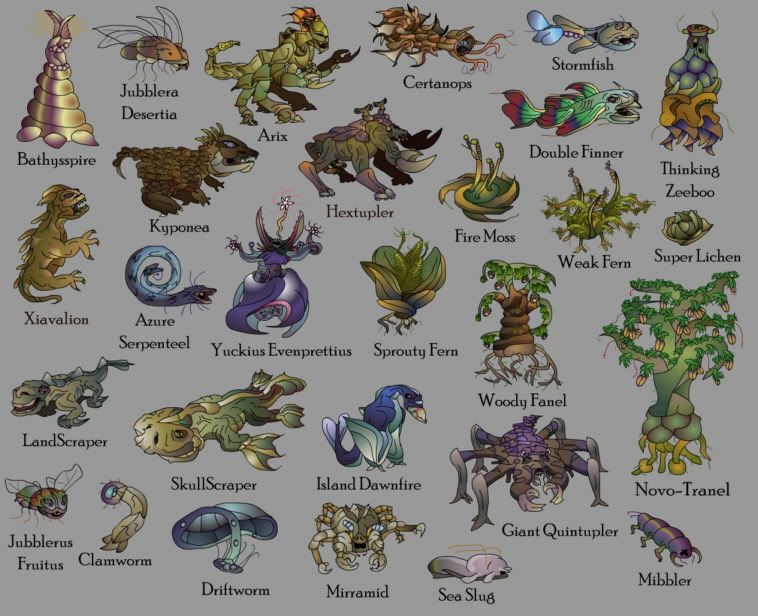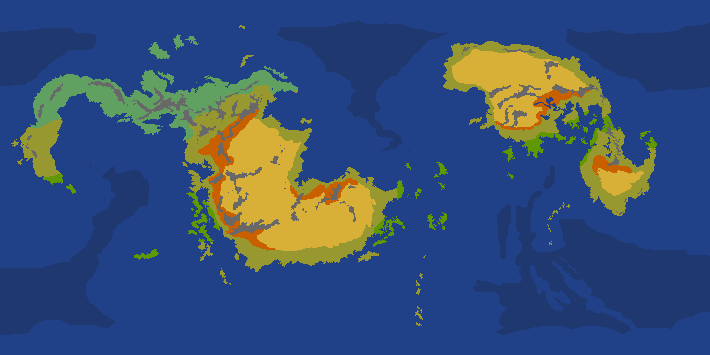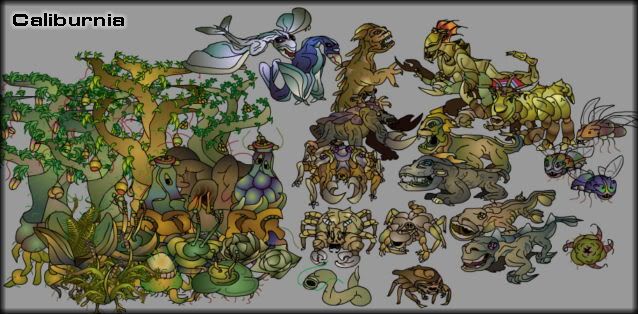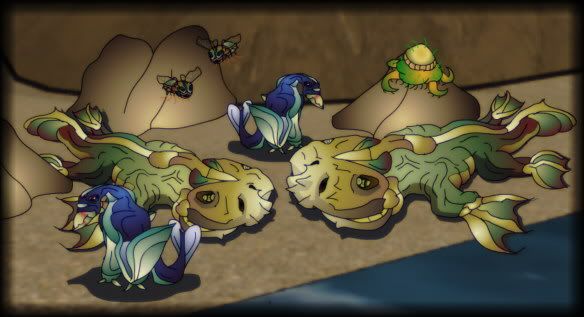Era 19: Profusion Event #4
This was an era of continued hardship, but also of recovery and diversification.
The world climate remained hot. Average temperatures had only dropped a few degrees by the end of this era. Much volcanic activity continued, and the atmosphere was still loaded with insulating gasses. The ice caps had still not reformed, so sea levels remained high.
Despite the harsh conditions, many new species appeared during this era, some of which seem to have done very well. It is clear that there were many empty niches left to fill after the previous disasters. Changes in ocean currents also spread more moisture over the land, at the same time as plant species were adapting to survive in drier conditions. As a result, many plants were able to flourish again, which supported more herbivores.
Back in the seas, plankton levels were increasing, but they still struggled to find enough oxygen in the warm water. Sea life was more abundant in the cooler polar oceans, but only during the seasons when there was enough sunlight.
New Evolutions:
Planet Map:
The Land:
The difference between the two continents was growing during this era. Both now had many unique plants and animals. From the new evolutions, only the flying animals and plants with airborne spores were able to establish themselves on both continents.
Jubblerus Desertia and
Jubblerus Fruitus were both successful in their different habitats. The Desertia was generally the most successful, as it colonised vast new areas of dry land. The older
Jubblerus Frigidus species still survived in a few corners.
The
Longbay Cloudfire was still very widespread, but was in some ways outshone by the emerging
Island Dawnfire species. The Dawnfires returned to a coastal-dwelling life. Though the Cloudfires were still the best fliers in the world, the Dawnfires had a stronger beak, which tended to win most arguments whenever the two species clashed.
Fire Moss and
Weak Fern were the main competitors for the open plains during this era. Both did well in different circumstances - the Fire Moss's strategy was to be simple, tough, and to recover quickly from damage, while the Weak Fern focused on producing masses of airborne spores. But neither was able to colonise any further into the desert than earlier plants.
Meanwhile the
Sprouty Fern had the largest leaves of any plants up to this time. Many fossil imprints of these leaves have been found in the fossil record. They seem to have been very efficient at gathering light, but also made the plant more vulnerable to drying out, despite any other adaptations it had. Nonetheless, Sprouty Ferns did better than other ferns wherever there was enough moisture. They were one of the few plants to abandon their defences against the cold, which helped them to thrive in the warmth.
This led to 'Fern Jungles' which began to appear across the planet. These were areas of dense vegetation, consisting mainly of Sprouty Fern, with a scattering of other plants, but few of the Fanel/Tranel trees. These areas were not rich in tasty fruit like the true forests, but otherwise had many easily-accessible leaves and other plant material for those that could digest it properly.
Patchy Fern went extinct after branching into its two new forms.
Super Lichens evolved.
The
Clinging-Tick began to establish itself on land, or at least in swamps and lakes near the coast.
Caliburnia
Across the Orospeh sub-continent and the far north of Calibrunia, there was a generous increase in rainfall and a shift to a slightly-more-temperate climate. Dense forests of Tranels and Fanels began to reappear here, eventually combining into a vast continuous forest known as the 'Orania'. The
Novo-Tranel made up a large proportion of it - this species spent a lot of nutrients on producing abundant fruit that was a favourite of herbivores, and its unusual 'smart seeds' had some success in ensuring that new seedlings did not waste effort competing with each other.
The climbing
Clepsurytes were able to quickly repopulate this area. They were followed by predatory
Xiavalions, which could also climb trees, laid well-developed eggs, and were attentive parents, all of which combined with the abundant and easily-caught Clepsurytes to ensure a very healthy population for their species.
As in previous eras, these forests also had enough small plants and fallen fruit to support large numbers of other animals. And the climbing species were not restricted to the forests, either. Some sub-species of Clepsurytes and Xiavalions were to be found living happily on mountainsides, cliff-faces and isolated plateaus.
Across the plains, more sophisticated walking species appeared, as animals responded to the need for long distance travelling in arid conditions. Both the
Hextupler and
Arix marked a departure from their earlier ancestors in terms of body design, and both seem to have done very well. The Arix in particular was the best adapted species for dry conditions at this time, able to follow its prey anywhere, on the horizontal plane at least. (Some fossilised Arixes have been found with remarkable things in their stomach, including the bones of a Giant Quinupler in one case. Scientists cannot explain how it got there.)
The
Audorix still survived in a few corners of forest and jungle where the Arix's advantages meant little. But the lungs and circulation system of the Hextupler gave it a more general advantage over the
Sextupler, which survived only in a semi-amphibious role.
Though still very numerous, the
Cronodids were not as abundant on the plains of Caliburnia as they had been before the recent disasters. Although they were well-armed and protected, they were also increasingly slow and awkward compared other species, facing much competition from the Hextupler in particular. But they had a few advantages left - such as their efficient digestion and resistance to poison, which allowed them to feed on Zeeboos like no other herbivore. And some Zeeboos could usually be found wherever any plants could grow. However, when Zeeboos grew in dense concentrations, and if they were being nibbled on too much, they produced haunting sounds which were uncomfortable for any animal like the Cronodid which could hear them...
The east coast of the continent was home to the largest stretch of Zeebooland, which was mainly made up of
Tougher Zeebos. The new
Thinking Zeeboo made up less than a third of it, despite being the hardiest plant ever seen up to this point. Much mystery surrounds the Zeeboo species of this time. It is clear that they were evolving a kind of nervous system with comparable properties to those seen in simple animals. But this came with great demands, and had no clear benefit. (Some scientists believe that the Thinking Zeeboos were able to cooperate with each other, and even with other Zeeboo species, in order to function as a kind of giant super-organism with coordinated growth and reproduction, and massive combined response to attacks from parasites and harmful microbes).
Meanwhile, the flooded valleys and islands around the shores of the continent were home to large colonies of amphibians and fliers, especially where they met with cool-water currents that were richer in oxygen, nutrients, plankton, and tasty sea animals.
The
LandScraper appeared along the south-west coast. Although adapted for a more inland lifestyle, it lacked weapons or any real defence except to swim away, which kept it near the coasts most of the time. It wasn't exactly safe in the water, either. It shared its habitat with amphibious predators like the Xiavalion and Sandavalion, and of course the many predators of the open ocean. Though, like the
Lungscraper, it was able to run riot on a few isolated islands further out from the mainland, which remained free of predators and competition.
Lemunesia
Between the continents, there was a growing chain of volcanic islands known as Lemunesia. This was home to large numbers of Cloudfires and Dawnfires. Initially, Lungscrapers were among the few land animals to live there. Some islands were covered with dense tropical vegetation (especially Sprouty Ferns) which supported huge populations of Lungscrapers - some grew into a giant species known as
SkullScrapers, armed with a reinforced club-like head, though they remained strict vegetarians.
Eventually a handful of other swimming colonists arrived from Caliburnia to disturb the peace - LandScrapers, Xiavalions, and Sandavalions, as well as Sextuplers, which had apparently been able to march across the seabed (having both proto-lungs and proto-gills). None of these had yet been able to cross the larger distance over to Agonia.
Agonia
The Zerith sub-continent pushed further into Agonia proper, gradually raising the surrounding seabed and creating a shallow warm sea, full of islands and peninsulas that received more rainfall that usual, and also had cold-water currents brining in more plankton. Known as the 'Zeribean', this area supported most life in Agonia, and attracted migrants like the Cloudfire and Dawnfire species.
The Zeribean Fern-Jungles had few big trees. Like in Caliburnia, they were mostly made up of Sprouty Ferns, but also had many of the small
Woody Fanel and
Scavenger Fanel species unique to Agonia, both of which produced tasty fruit for animals to eat. Woody Fanels had a much stronger structure than other plants of the time, making them more resistant to herbivores, and better able to resist storm damage. The fallen trunks also provided shelter for small animals. Clusters of these plants also spread out into the plains beyond. There are many well-preserved fossil fragments of Woody Fanels which date from this era.
One branch of the marooned
Terradid Mrk II's evolved into the
Mirramid, a tree climbing species that filled the gap left by the demise of the Clepsurytes in Agonia. But the species still spent a lot of time on the ground, due to the relative lack of trees.
The feathered
Kakoo had been almost wiped out in the previous era. But now the Kakoo, together with its more intelligent and sophisticated descendent the
Kyponea (both unique to this continent), became successful and versatile predators in the Zeribean. The Kyponea's advantages were balanced out by its greater appetite, so neither species replaced the other. But they were largely confined to this region by their need to stay near water.
Beyond the Zeribean lay open plains, where only the more hardy animals survived.
Hibroytes were very common here, along with occasional roving bands of Sandavalions, Terradid Mrk II's, and Miramids. Sandavalions were still the most successful hunter on the Agonian plains. Kakoos and Kyponeas were only found on the plains near rivers at lakes.
The plains continued towards the central deserts and Zeeboolands, gradually becoming too arid for most animals to survive. The surrounding Zeeboolands were more primitive compared to Caliburnia, consisting only of
Multiplying Zeeboo. This was simpler, faster-growing, and hardy enough, but could not spread as far into the deserts and mountains.
Terradid MrkII's were still the most widespread animals across all of Agonia, living almost everywhere except the deserts and mountains. Though not as sophisticated as the Calibrunian Cronodids, they often enjoyed a relatively trouble-free life in areas too dry for any surviving Agonian predators to follow.
The Oceans
The plankton-based ecosystem was based on the cool waters near the poles, while the plant/sponge based system was based on shallow waters near the equator. The plant-eaters rarely had to migrate far, and neither did the predators that fed on them. But the plankton-eaters often had to cross vast distances of turbulent ocean every year...
The problem was the effect of the seasons outside of the tropics - the best plankton blooms occurred wherever water was cool enough to hold ample oxygen, combined with strong sunlight to drive photosynthesis. This ideal zone was never more than a thin band around the planet, somewhere between one of the poles and the equator. It was always growing, shrinking, and moving from one pole to another. Winter darkness would come, while new plankton booms occurred at the opposite end of the planet.
The versatile
Double Finner did well enough to survive, and was rarely caught by any predators, but its population was dwarfed by the shoals of Cloudfish-related species that gradually began to reappear across the ocean. The
Stormfish gradually became the most numerous of these, though the
Redfish was also doing well. They were comparatively simple creatures, able to reproduce very quickly, and highly social, all of which suited a migrating lifestyle. They were also very effecient at filtering and digesting plankton. Though, they were also slow and dumb enough to be caught by a large variety of predators...
By swarming together, they confused attackers and defended themselves with large numbers of small biting mouths. But there were also predators with either the armour or the tactics to get around this - like the
Shy Hunter or
Sociavalion Mrk IVs. Much of their population was being eaten to support the predators, but the shoals were able to keep reprodcing at the same rate.
Shellster Kipinus and
Certanops also drifted and wandered across the oceans. The Certanops efforts to become more mobile were helped by ditching its shell in favour of a more flexible exoskeleton. The Shellster Kipinus survived as a more sluggish species that preferred the shelter of plants and sponges in the warm water, despite the lack of plankton there. With the growing abundance of other soft-bodied prey, neither these species were bothered much by predators.
The Double Finners and
Xoso Finners continued to do well wherever sea plants grew, but especially in clear warm waters where they could make the most of their speed and vision advantages.
The
Bubble Zeeboo was gradually evicting the ancient cold-water plant species from the warm waters.
The shallow Zeribean sea was particularly rich in marine life, as was the south-west coast of Caliburnia, both places that sheltered an outburst of new warm-water species like the
Mibbler (related to the Dibbler Ice 2.0),
Sea Slug,
Clamworm and
Driftworm. The Zeribean sea floor was however disturbed by the appearance of the fearsome
Giant Quintuplers and occasional visits by wandering SkullScrapers, not to mention constant airborne patrols of Cloudfires and Dawnfires.
The
Azure Serpenteel was a successful and versatile hunter/scavenger, widespread across the whole ocean. Its acute sense of vibration was particularly useful in the dark depths.
Speaking of which, the
Bathysspire added to the variety of lifeforms on the deep ocean floor. It spent most of its limited energy on reproduction, ensuring that it was always among the first of its kind to colonise new volcanic vents - though individual spires were rarely able to grow to their full size, and were sometimes vulnerable to the inquisitive nibblings of various animals.
Finally, the
Yuckius Evenprettius added some sparkle to the abyss. Curiously, it was able to survive at even greater depths than the average ocean floor, IE ocean trenches where no real prey was to be found at this time. Some scientists think that the Evenprettius may have gathered down there to breed without being disturbed, using their light-emitting lures to attract each other and for courtship displays. In any case, it's somewhat odd lifestyle meant that the older Yuckius Prettius still had a place in things.
Bonuses:
Plant award: Woody Fanel.
Grombar has +1 gene bonus.
Animal award: Azure Serpenteel.
Thlayli has +1 gene bonus.
Innovation award: Bathyspire.
TerrisH has +1 gene bonus.
Survival award: Cryoalgae.
Niklas has +1 gene bonus.
Story award: Lord Iggy has +1 gene bonus.
Problems:
@LittleBoots, I changed the Xiavalion's 'complex eggs' to 'large eggs' which I guess is pretty much the same thing.
Species Stats:
Recently extinct creatures are still shown in the word doc, but they are highlighted in bright red. They are not shown in the txt.




















